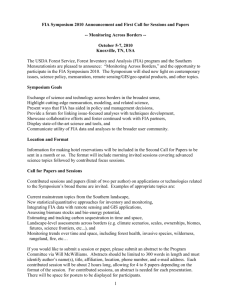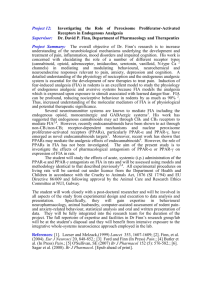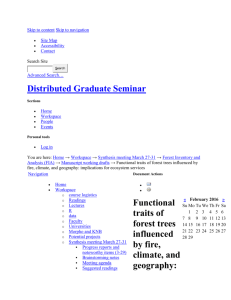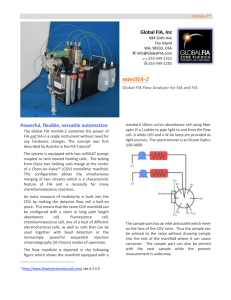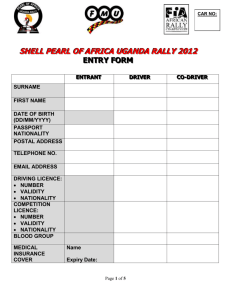Submission Format - National Centre of Excellence in Geology
advertisement
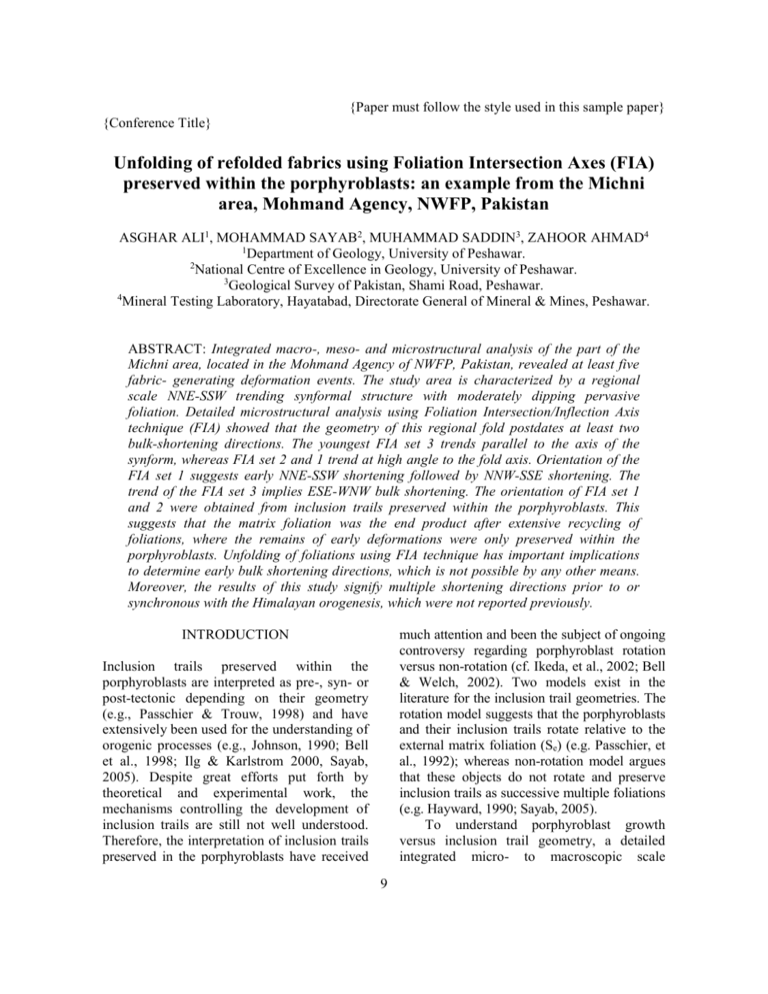
{Paper must follow the style used in this sample paper}
{Conference Title}
Unfolding of refolded fabrics using Foliation Intersection Axes (FIA)
preserved within the porphyroblasts: an example from the Michni
area, Mohmand Agency, NWFP, Pakistan
ASGHAR ALI1, MOHAMMAD SAYAB2, MUHAMMAD SADDIN3, ZAHOOR AHMAD4
1
Department of Geology, University of Peshawar.
2
National Centre of Excellence in Geology, University of Peshawar.
3
Geological Survey of Pakistan, Shami Road, Peshawar.
4
Mineral Testing Laboratory, Hayatabad, Directorate General of Mineral & Mines, Peshawar.
ABSTRACT: Integrated macro-, meso- and microstructural analysis of the part of the
Michni area, located in the Mohmand Agency of NWFP, Pakistan, revealed at least five
fabric- generating deformation events. The study area is characterized by a regional
scale NNE-SSW trending synformal structure with moderately dipping pervasive
foliation. Detailed microstructural analysis using Foliation Intersection/Inflection Axis
technique (FIA) showed that the geometry of this regional fold postdates at least two
bulk-shortening directions. The youngest FIA set 3 trends parallel to the axis of the
synform, whereas FIA set 2 and 1 trend at high angle to the fold axis. Orientation of the
FIA set 1 suggests early NNE-SSW shortening followed by NNW-SSE shortening. The
trend of the FIA set 3 implies ESE-WNW bulk shortening. The orientation of FIA set 1
and 2 were obtained from inclusion trails preserved within the porphyroblasts. This
suggests that the matrix foliation was the end product after extensive recycling of
foliations, where the remains of early deformations were only preserved within the
porphyroblasts. Unfolding of foliations using FIA technique has important implications
to determine early bulk shortening directions, which is not possible by any other means.
Moreover, the results of this study signify multiple shortening directions prior to or
synchronous with the Himalayan orogenesis, which were not reported previously.
INTRODUCTION
much attention and been the subject of ongoing
controversy regarding porphyroblast rotation
versus non-rotation (cf. Ikeda, et al., 2002; Bell
& Welch, 2002). Two models exist in the
literature for the inclusion trail geometries. The
rotation model suggests that the porphyroblasts
and their inclusion trails rotate relative to the
external matrix foliation (Se) (e.g. Passchier, et
al., 1992); whereas non-rotation model argues
that these objects do not rotate and preserve
inclusion trails as successive multiple foliations
(e.g. Hayward, 1990; Sayab, 2005).
To understand porphyroblast growth
versus inclusion trail geometry, a detailed
integrated micro- to macroscopic scale
Inclusion trails preserved within the
porphyroblasts are interpreted as pre-, syn- or
post-tectonic depending on their geometry
(e.g., Passchier & Trouw, 1998) and have
extensively been used for the understanding of
orogenic processes (e.g., Johnson, 1990; Bell
et al., 1998; Ilg & Karlstrom 2000, Sayab,
2005). Despite great efforts put forth by
theoretical and experimental work, the
mechanisms controlling the development of
inclusion trails are still not well understood.
Therefore, the interpretation of inclusion trails
preserved in the porphyroblasts have received
9
structural analyses have been carried out in
the multiply deformed metamorphic rocks of
the Mohmand Agency, NWFP, northern
Pakistan (Fig. 1). Foliation Intersection/
Inflection Axes technique (FIA) has been used
to unfold the refolded fabrics that are
preserved either in the matrix or in the
porphyroblast. The microstructural data were
compared with the field observations and
orientation data to resolve the kinematic
evolution of the study area, which is rather
poorly documented in the literature. This in
turn puts important insights for porphyroblasts
to test whether these geological objects rotate
or not in the viscous flow rotational paths.
Fig. 1.
Map showing major tectonostratigraphic zones of the northern Pakistan. Box shows the
location of the study area.
GEOLOGICAL SETTING
i.e., the closure of Tethys Ocean and the
collision of Indian with the Asian plate (e.g.,
Tahirkheli, 1979). The collision was episodic
Himalayas are one of the best examples of
in terms of magmatism, deformation, regional
curstal- scale continent-continent collision,
10
15/ North latitude and lies between the
Khairabad-Panjal thrust and Main Mantle
Thrust (MMT). The area consists of two
dominant but undifferentiated litho-tectonic
units of Silurian (?) age called as Yousaf Khel
and Gandao formations (Sadin & Aslam,
1987). The names are not yet approved by the
Stratigrahpic Committee of Pakistan (pers.
comm., M. Sadin, 2005). The Yousaf Khel
formation consists of meta-dolomite, partly
metamorphosed limestone, marble, calcareous
schist, phyllite and siliceous schist and the
Gandao formation consists of quartz-mica
schist, graphitic schist, garnet-mica schist and
amphibolite schist (Sadin & Aslam, 1987).
The area forms roughly NNE-SSW trending
and northeastward plunging synformal
structure (Sadin & Aslam, 1987). Both the
Yousaf Khel and Gandao formations are
folded along this structure. Because of its
abundant porphyroblastic assemblage and nice
exposure of L-S tectonites, the area provides
an excellent sight to study the behavior of
porphyroblasts during folding.
metamorphism and exhumation. Most of the
field, petrographic and geochronological
studies provide adequate evidences to suggest
that the main metamorphic event in the rocks
of the Himalayas is associated with the
Tertiary Himalayan Orogeny (e.g. Treloar et
al., 1989ab). Regional scale litho-tectonic
maps of northern Pakistan show distinct
geologic entities that are made up of (1) the
northern margin of the Indian plate i.e.,
Tethyan sediments and Himalayan foreland
molasse basin, (2) one or more Asian
microcontinents in its north and northwest,
and (3) a series of island arcs and ophiolites
between (1) and (2). In the northern Pakistan,
the Indian plate is separated from the
Karakoram by the Kohistan magmatic arc,
which was welded to Karakoram plate during
the Late Cretaceous (100-85Ma; Coward et
al., 1987; Treloar et al., 1989ab) and to the
Indian plate during Paleocene (66-56Ma;
Beck et al., 1996).
Pre-Himalayan metamorphic rocks are
exposed as discontinuous patches around the
Peshawar basin, south of the Main Mantle
Thrust (MMT) and are poorly documented in
the literature (e.g. DiPietro, et al., 1999).
Some of these patches belong to the primitive
Hazaran Orogeny (Baig et al., 1988). The
study area appears to be the part of the PreHimalayan metamorphism and deformation,
understanding of which will intuit to the
recognition of pre-Himalayan deformation
events (see below). The study area is a part of
the Mohmand Agency locally known as
Michni and located in the west of the
Peshawar city (Fig. 1). The area covers 71o20/
and 71o 30/ East longitude and 34o 10/ and 34o
METHODOLOGY
Mesoscopic studies
The geological information was plotted on the
Survey of Pakistan toposheet No. 38N/8 at
1:12,000. In this regard, a generalized geological
map prepared with special emphasis on structural
overprinting relationships (Figs. 2 & 3). Structural
elements, both foliations and lineations, were
plotted on the map and on the lower-hemisphere,
equal-area stereographic projections. 18 spatially
oriented porphyroblastic, garnet-bearing samples
were collected for detailed microstructures
analysis (Fig. 4).
11
Fig. 2.
Shows generalized geological map of the study area. Two distinct foliation strikes (S4)
define the limbs of the synform with calculated axis. See text for further discussion.
12
Fig. 3.
Map showing the spatial distribution of mineral and intersection lineations.
13
Fig. 4.
Map showing the spatial distribution of oriented rock samples and FIA trends. FIA trends are
plotted on rose diagrams. Note, distinct FIA orientations with respect to North.
14
the inferred trend of the synformal structure.
The NW-SE and NE-SW striking foliations
exposed on the limbs are characterized as
matrix and termed here as S4 based on detailed
microfabric overprinting relationships (see
below). S5 is shallowly dipping and makes an
intersection with S4 as L45 (Figs. 3 & 6). The L45
is moderately plunging towards the north (Fig.
3). Mineral stretching lineation is moderately
to shallowly plunging towards NW and well
developed on S4 cleavage and, therefore
defined as L44 (Figs. 3 & 7).
Laboratory work
Oriented rock samples were impregnated in
the lab with commercially available rock jelly
to externally bond the highly cleaved schistose
rocks. The impregnated samples were reoriented using the orientation table available
in the Department of Geology, University of
Peshawar. Horizontal slabs were then marked
and cut with reference to true north in the
Mineral Testing Laboratory (MTL), Peshawar.
Multiple vertical blocks were marked around
the compass and cut from these horizontal
slabs in thin section laboratories of the NCE in
Geology and the Department of Geology,
University of Peshawar. Six vertical oriented
thin sections were prepared from vertical
blocks at 30o increments i.e. 360o, 30o, 60o,
90o, 120o, and 150o. This range covers
complete 3-D view of the rock sample for
detail FIA analysis (see below).
SAMPLE DESCRIPTION
14 samples were analyzed for FIA and
microfabrics. The metamorphic assemblage
visible in various thin-sections consists of Grt,
Amp, Bt and Ms (symbols after Kretz, 1983).
Garnet porphyroblasts range in size from 1mm
to 4mm and were used for inclusion trail
microstructural study. The inclusion trails
observed
within
the
porphyroblasts
dominantly range from sigmoidal to staircase
geometries.
OVERPRINTING FABRIC RELATIONSHIP
Outcrop data
Outcrop measurements show two dominant
strikes, that is, NW-SE and NE-SW with
moderately dipping foliations in the NE and
NW, respectively (Figs. 2 & 5). The
calculated -axis moderately plunges towards
the NNE and appears to be consistent with
Fig. 5.
15
Outcrop exposure of moderately
dipping (49o) and NE-SW striking
S4 foliation. S4 is penetrative, nearly
continuous and smooth foliation.
Photo taken looking NE.
with one cut every 30o around the compass.
The trend of the FIA is located where the flip
occurs between two adjacent vertical oriented
thin sections when viewed in one direction
(Fig. 10). Where both asymmetries are
observed equally (both ‘S’ and ‘Z’), but the
asymmetry in vertical thin sections to either
side are switched, the FIA is considered to lie
in the plane of that section (e.g. Sayab, 2005).
In this study 115 oriented thin sections were
prepared to obtain the FIA trends.
Micro-structural studies
14 oriented rock samples were studied for
detailed microstructural analysis. To establish
overprinting relationships, all microstructural
observations were carried out on thin sections
that were cut perpendicular to the foliations or
‘A’ sections (see e.g., Johnson et al., 2006).
The foliations are numbered in chronological
order with respect to successive deformations,
that is, S1, S2, S3…, as D1, D2, D3…,
respectively. S1, where preserved, is flat lying
and has only been observed as inclusion trails
in the cores of the porphyroblasts (Fig. 8). S2
is observed as steep foliations at the coremedian region of the garnet porphyroblasts.
S3, very similar in orientation to that of S1, is
subhorizontal and preserved in the median-rim
region of the garnet. S4 in all the oriented thin
section is moderately to steeply pitching and
observed in the rim of the porphyroblasts and
continuous with the matrix. The S4 in the
matrix is typically identical to stage 5 or 6 of
Bell and Rubenach (1983) differentiated
crenulation cleavage classification scheme.
This suggests that D4 obliterated and/or
transposed early formed fabrics. However,
older fabrics were only preserved as inclusion
trails in the porphyroblasts. Moderately
pitching S5 was observed in few rock samples
(Fig. 9), which appears to be the younger
deformation fabric and correlates well with
the outcrop shallow lying S5 (cf. Figs. 6 & 9).
FIA measurements are made relative to
both geographic coordinates and a line
perpendicular to the earth’s surface. To
measure FIAs in three dimensions, a
minimum of six vertical oriented thin sections
were cut from each spatially oriented sample,
Fig. 6.
16
Photo and associated line sketch
showing NNW striking subvertical
foliation S4, which formed by
subhorizontal shortening. The S4 in
turn is overprinted by ENE-WNW
striking S5, which formed during
subvertical shortening. Photo taken
looking NNW.
Fig. 7.
Photo showing biotite mineral stretching lineation, L44. The lineation is shallowly
plunging towards NW. Amphibole needles overprinted L44 and randomly oriented. Photo
taken looking towards SW.
Fig. 8.
Four near-orthogonal fabrics identified within the garnet porphyroblast. Garnet core
preserves shallow S1, followed by steep S2 in the core-median, shallow S3 and steep S4
in the median-rim region. S4 is partially continuous with the matrix. See text for further
discussion.
17
Fig. 9.
Photomicrograph (a) and line diagram (b) showing matrix foliation in sample M04. The
matrix foliation S4 is overprinted by a weak subhorizontal crenulation S5. Note, biotite
flakes re-oriented in S5 direction. Vertical thin section with single barbed arrow showing
030o strike and way up.
Studies involving FIAs have the advantage
that FIAs form in response to shortening,
irrespective of whether porphyroblasts rotate
relative to one another or not (e.g., Johnson,
1999). Thus, focusing in FIA trends, rather
than inclusion trails orientation can be used as
a tool for the controversy over porphyroblasts
kinematics and rotation verses non-rotation
models.
FIAs from garnet porphyroblasts
Foliation
Intersection/Inflection
Axes
preserved in the porphyroblasts (FIAs)
The Foliation intersection/ inflection axis
(FIAs) technique was first established by
Hayward (1990) and modified by Bell et al.,
(1995). FIAs have successfully been used to:
(1) link deformation and folding events (e.g.,
Timms, 2003) (2) understand complex
structural histories in the rocks (e.g., Cihan,
2004), and (3) to determine the multiple
shortening directions (e.g., Sayab, 2005).
18
14 FIA measurements were obtained from
garnet porphyroblasts. Three sets were
recognized after plotting the FIA data on rose
diagrams (Fig. 4; Table 1). The FIA sets were
distinguished based on the 1) continuity of
inclusion trails with the matrix foliation (e.g.
Adshead-Bell & Bell, 1999), and 2)
orientation of the FIA trend with respect to the
regional foliation. The younger set, FIA 3,
trends parallel to the present day matrix
foliation and is trending NNE-SSW. Almost
all the inclusion trails preserved within the
garnet porphyroblasts belonging to the FIA set
3 are continuous with the matrix foliation. FIA
set 2 oriented ENE-WSW and lies at an acute
angle to the FIA set 3, whereas FIA set 1 is
trending ESE-WNW and makes an obtuse
angle to the youngest FIA set 3. FIA 1 garnets
are generally characterized by those having
truncated inclusion trail geometries with the
matrix.
Unfolding of overprinted fabrics using FIA
approach
Three FIA sets have been recognized both on
the eastern and western limbs of the synformal
structure and indicate three independent
shortening directions (Fig. 4). FIA set 3
formed as a result of ESE-WNW, FIA set 2 by
NNW-SSE and FIA set 1 by NNE-SSW. The
orientation of both FIA set 1 and 2 are close to
each other suggesting bulk N-S shortening.
Thus, before ESE-WNW bulk shortening,
there was a period of N-S shortening event.
This primitive bulk N-S shortening event was
recognized based on the inclusion trail
geometry form oriented rock specimens using
FIA approach and is not possible by any other
means. It is concluded here that before ESEWNW shortening, there was at least one major
N-S shortening event in the Michni area.
TABLE 1. SAMPLES WITH GEOGRAPHICAL COORDINATES AND FIA SETS
S.No
M1
M2
M3
M4
M5
M6
M9
M10
M11
M12
M13
M14
M15
M16
Northing
3413192
3413192
3413750
3413292
3413292
3413541
3413647
3413647
3413647
3413647
3413586
3413586
3413558
3413549
Easting
7127741
7127741
7127830
7125546
7125546
7125456
7125326
7125326
7125326
7125326
7125343
7125343
7125281
7125250
Garnet FIA Core- Rim
15
15
15
30
75
75
75
0
105
15
15
105
15
30
19
FIA1
FIA2
FIA3
15
15
15
30
75
75
75
0
105
15
15
105
15
30
Fig. 10. Photomicrographs and line diagrams from vertical oriented thin sections showing
asymmetry method to determined the FIA (Sample M11; see Fig. 4 for location). (a), (b),
(c) and (d) show garnet porphyroblasts with clockwise asymmetry (CW) in sections
striking 3600, 0300, 0600 and 0900 respectively. (e) and (f) show garnet porphyroblasts
with anticlockwise (ACW) asymmetry in thin sections striking 120 0 and 1500
respectively. In this case, FIA lies between 090 0 and 1200 thin sections at 1050.
20
DISCUSSION AND CONCLUSIONS
Adshead-Bell, N.S. & Bell, T.H., 1999. The
progressive development of a macroscopic
upright fold pair during five near-orthogonal
foliation-producing
events:
complex
microstructures
versus
a
simple
macrostructure. Tectonophys., 306, 121-147.
Aerden, D.G.A.M., 1995. Porphyroblast nonrotation during crustal extension in the
Variscan Pyrenees. J. Struct. Geol., 17, 709726.
Baig, M.S., Lawrence, R.D. & Snee, L.W., 1988.
Evidence for late Precambrian to Early
Cambrian orogeny in northwest Himalaya,
Pakistan. Geol. Mag., 125, 83-86.
Beck, R.A., Burbank, D.W., Sercombe, W.J.,
Khan, A.S. & Lawrence, R.D., 1996. Late
Cretaceous ophiolite obduction and Paleocene
India-Asia collision in the westernmost
Himalaya. Geod. Acta., 9, 114-144.
Bell, T.H. & Rubenach, M.J., 1983. Sequential
porphyroblast growth and crenulation
cleavage development during progressive
deformation. Tectonophys., 92, 171-194.
Bell, T.H. & Welch, P.W., 2002. Prolonged
Acadian orogenesis: revelations from
foliation intersection axis (FIA) controlled
monazite
dating
of
foliations
in
porphyroblasts and matrix. Am. J. Sci., 302,
549-581.
Bell, T.H., Forde, A. & Wang, J., 1995. A new
indicator of movement direction during
orogenesis: measurement technique and
applications to the Alps. Nerra Nova, 7, 500508.
Bell, T.H., Hickey, K. A. & Upton, J.G., 1998.
Distinguishing and correlating multiple
phases of metamorphism across a multiply
region using the axes of spiral, staircase and
sigmoidal inclusion trails in garnet. Jour.
Meta. Geol., 16, 767-794.
Cihan, M., 2004. The drawbacks of sectioning
rocks relative to fabric orientations in the
matrix. A case study from the Robertson
River Metamorphics (Northern Queensland,
Australia). J. Struct. Geol., 26, 2157-2174.
Coward, M.P., Butler, R. W. H., Khan, M. A. &
Knipe, R. J., 1987. The tectonic history of
In highly tectonized terranes, tracking back the
deformation events are always problematic
because of the penetrative effects of the younger
deformations. Albeit, early fabrics tend to either
transposed or obliterate during younger ductile
deformations, their remains may be preserved as
inclusion trails in low strain zones, e.g.
porphyroblasts (e.g., Ramsay 1962; Fyson,
1980; Aerden, 1995). Therefore, the geometry
of the inclusion trails can potentially be used to
reconstruct the shortening directions of primitive
deformation events that are no longer preserved
in the matrix foliation (e.g. Sayab, 2005).
In this study, three independent FIA sets
have been determined and used to reconstruct
the bulk shortening directions. The consistency
of the FIA data across the map-scale synform
has important implications for crustal scale
processes. The primitive N-S shortening was not
reported previously. The orientation of FIA sets
1 and 2, which are trending at high angle to the
youngest FIA set 3 and the regional strike of the
foliation in the area, suggests that garnet
porphyroblast did not rotated and behaved as
rigid objects (see also Bell et al., 1998). If they
were rotated then both the FIA set 1 and 2 must
have aligned parallel to the FIA set 3. This is not
clearly the case and further suggests that
porphyroblasts, especially the garnets, grew
episodically and preserved the deformation
events as successive inclusion trails. Further
research is required to date these early N-S and
younger E-W deformation to put these events
into the regional Himalayan orogenesis.
Acknowledgements: Mohammad Sayab would
like to thank Mohammad Khan (Driver) of the
NCE in Geology, University of Peshawar for
helping in the field. Rashid and Razaq deserve
special thanks for helping in the preparation of
oriented thin sections.
REFERENCES
21
Kohisttan and its implications for Himalayan
structure. J. Geol. Soc. Lon., 144, 377-391.
DiPietro, J.A., Pogue, K.R., Hussain, A. &
Ahmad, I., 1999. Geologic map of the Indus
syntaxis and surrounding area, northwest
Himalaya, Pakistan. Geol. Soc. Am. Sp.
Pap., 328, 159-178.
Fyson, W. K., 1980. Fold fabrics and
emplacement of an Archean granitoid pluton,
Cleft Lake, Northwest Territories. Canadian
J. Earth Sci., 17, 325-332.
Hayward, N., 1990. Determination of early fold
axis orientation within multiply deformed
rocks using porphyroblasts. Tectonophys.,
179, 353-369.
Ikeda, T., Shimobayashi, N., Wallis, S. R. &
Tsuchiyama, A., 2002. Crystallagraphic
orientation, chemical composition and threedimensional geometry of sigmoidal garnet:
evidence for rotation. J. Struct. Geol., 24,
1633-1646.
Ilg, B.R. & Karlstrom, K.E., 2000. Porphyroblast
inclusion trail geometries in the Grand
Canyon: evidence for non-rotation and
rotation? J. Struct. Geol., 22, 231-243.
Johnson, S. E., 1990. Lack of porphyroblast
rotation in the Otago schists, New Zealand:
implications for crenulation cleavage
development, folding and deformation
partitioning. J. Meta. Geol., 8, 13-30.
Johnson,
S.E.,
1999.
Porphyroblast
microstructures: a review of current and
future trends. Am. Min., 84, 1711-1726.
Johnson, S.E., Duppee, M.E. & Guidotti, C.V.,
2006. Porphyroblasts rotation during
crenulation cleavage development: an example
from the Mooselookmeguntic pluton, Maine
USA. J. Meta. Geol., in press.
Kretz, R., 1983. Symbols for rock-forming
minerals. Am. Min., 68, 277-279.
Passchier, C.W. & Trouw, R.A.J., 1998. Microtectonics. Springer-Verlag, Berlin.
Passchier, C.W., Trouw, R.A.J., Zwart, H.J. &
Vissers,R.L., 1992. Porphyroblast rotation:
eppur si muove? J. Meta. Geol., 10, 283-294.
Ramsay, J.G., 1962. The geometry and mechanics
of formation of similar type folds. J. Geol.,
70, 309-327.
Sadin, M. & Aslam, M., 1987. Minerals
Reconnaissance in Mohmand Agency,
FATA, Pakistan. Geol. Surv. Pak. Inf. Rel.
No., 284.
Sayab, M., 2005. Microstructural evidence for NS shortening in the Mount Isa Inlier (NW
Queensland, Australia): the preservation of
early W-E trending foliations in
porphyroblasts revealed by independent 3D
measurement techniques. J. Struct. Geol., 27,
1445-1468.
Tahirkheli, R.A.K., 1979. Geology of Kohistan
and adjoining Eurasian Indo-Pakistan
continents, Pakistan. Geol. Bull. Univ. Pesh.,
11, 1-30.
Timms, N.E., 2003. Garnet porphyroblast timing
and behaviour during fold evolution:
implications from a 3-D geometric analysis
of a hand-sample scale fold in a schist. Jour.
Meta. Geol. 21, 853-873.
Treloar, P.J., Rex, D.C., Guise, P.G., Coward,
M.P., Searle, M. P., Windley, B.F., Petterson,
M.G., Jan, M.Q. & Luff, I.A., 1989a. K-Ar
and Ar-Ar geochronology of the Himalayan
collision in NW Pakistan: Constraints on the
timing
of
suturing,
deformation,
metamorphism and uplift. Tectonophys., 8,
881-909.
Treloar, P.J., Williams, M.P. & Coward, M.P.,
1989b. Metamorphism and crustal stacking
in the north Indian plate, North Pakistan.
Tectonophys., 165, 167-184.
22

